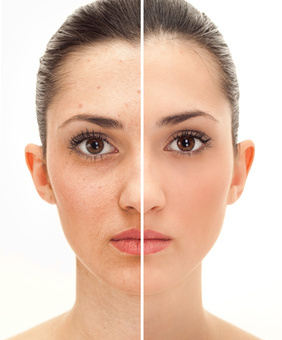
The skin undergoes a natural cell turnover process. It continuously generates new skin cells at the dermis which rise to the surface (epidermis) and slowly die off. Dead skin cells at the surface become keratinized (filled with keratin) and gradually shed to make way for the next wave of new skin cells.
As we age the cell turnover process tends to slow down. Older cells on the surface take longer to slough off, resulting in a dry or rough appearance of the skin. The pile up of old skin and debris also blocks the pores, spurring acne, other blemishes, and a dull skin tone in some individuals.
Skin exfoliating is beneficial as it removes the old cells and debris, revealing the younger and fresher looking skin below. Regular exfoliation also helps topical skincare products like anti-aging serums to better penetrate the skin and be more effective.
Common types of exfoliation
Mechanical Exfoliation. The dead skin cells are physically rubbed off with an abrasive. Examples of mechanical exfoliation include
- Scrubs (with sugar, salts, coffee grinds or seeds) should use small, round, gentle abrasives like jojoba beads. Stay away from something harsh like apricot scrubs, which can cause micro-tears in your skin.
- Rub-off cream (gommage mechanical peel) that you apply in a thin layer, let dry for a few minutes, then rub the product off and it takes the dead skin with it.
- Brush (rotary bristles)
Microdermabrasion is a process that is achieved by using a highly controlled spray of fine micro-crystals under pressure and vacuum. It is also available in crystal-free, or diamond-tip. Most effective as a series of 4-6 treatments, this procedure acts to remove the outermost layer of skin by a gentle abrasion or a polishing type process. (feels very similar to a rough cat’s tongue) Microdermabrasion is effective in reducing fine lines, fine crow’s feet, mild age spots and superficial acne scars and acne marks.
Chemical Peels provide a deep detoxifying and cleansing effect without being overly irritating to most skin types. This treatment stimulates blood circulation and renews the cellular systems to help brighten and clarify your complexion. Results have shown that long-term use of chemical peels encourages the stimulation of collagen growth in the skin, which slows the development of lines, wrinkles and sagging skin.
Types of Chemical Peels
Enzymes (biological or herbal), alphahydroxy acids (AHAs) or betahydroxy acids (BHAS) loosen the glue-like substance that holds the cells together, allowing them to slough away. These facial peels are a form of chemical exfoliation. Chemical peels can either be very gentle or very aggressive, depending on how the strong the peel is. Body treatments might use mild chemical exfoliants like pineapple enzymes.
What you need to know about exfoliation:
- Over-exfoliation triggers the inflammatory response, leading to a compromised lipid barrier that won’t function properly, a sensitized skin condition, and accelerated premature aging.
- Be extra careful when exfoliating delicate skin of your face. It’s easy to over-exfoliate. Talk to a good esthetician about the product and frequency that is best for your skin.
- Over use of peels can remove too much of your protective layer and end up exposing the living dermis.
- Microdermabrasion can make thin, aging skin even thinner if you get too many treatments too quickly.
- Avoid the sun after microdermabrasion or peels.
- Never use body scrubs on the face. They’re too rough.
- Never wax if you’ve had a peel recently. It might expose raw, living skin, which will have to scab over to heal.





